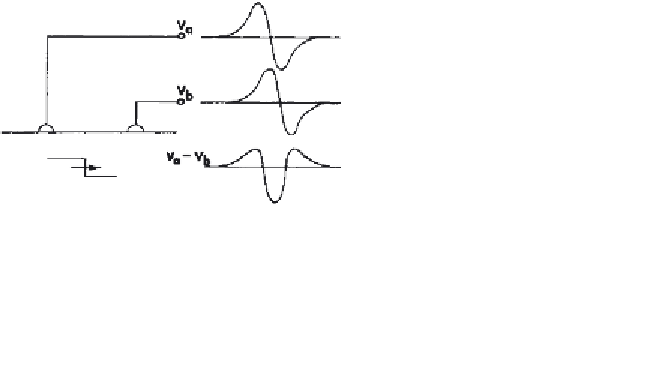Biomedical Engineering Reference
In-Depth Information
different for every point source; thus, each action potential decreases as
r
f
increases, as is seen in F. The phase of each point-source action potential has
the same zero-crossing time, but the smaller action potentials from the further
point sources are slightly longer in duration. Finally, G compares the net
action potentials from a point source, strip A, strip D, and a square electrode
10
10 mm
2
. As is evident from these action potentials, it is desirable to
use electrodes with as small a surface area as possible. Also, as will be seen
in Section 10.2.5, the smaller surface area electrodes are less influenced by
cross-talk.
The zone of pick-up for individual fibers by an electrode depends on two
physiological variables,
I
and
r
. Larger muscle fibers have larger dipole
currents, which increase with the diameter of the fiber. For an m.u.a.p., the
number of fibers innervated must also be considered. The potential detected
from the activation of a motor unit will be equivalent to the sum of the
constituent fiber potentials. Therefore, the pick-up zone for a motor unit that
innervates a large number of fibers will be greater than that for a unit with
fewer fibers. An estimate of the detectable pick-up distance for small motor
units (50 fibers) is about 0.5 cm and, for the largest motor units (2500 fibers),
about 1.5 cm (Fuglevand et al., 1992). Thus, surface electrodes are limited
to detecting m.u.a.p.'s from those fibers quite close to the electrode site and
are not prone to pick up from adjacent muscles (called
cross-talk
) unless the
muscle being recorded from is very small.
Most EMGs require two electrodes over the muscle site, so the voltage
waveform that is recorded is the difference in potential between the two
electrodes. Figure 10.3 shows that the voltage waveform at each electrode
is almost the same but is shifted slightly in time. Thus, a biphasic potential
waveform at one electrode usually results in a difference signal that has three
phases. The closer the spacing between the two electrodes, the more the
difference signal looks like a time differentiation of that signal recorded at a
single electrode (Kadefors, 1973). Thus, closely spaced electrodes result in
the spectrum of the EMG having higher-frequency components than those
recorded from widely spaced electrodes.
×
Figure 10.3
Voltage waveform present at two electrodes because of a single propa-
gating wave. Voltage recorded is the difference voltage
V
a
−
V
b
, which is triphasic in
comparison with the biphasic waveform seen at a single electrode.










Search WWH ::

Custom Search